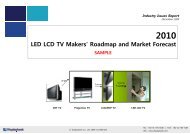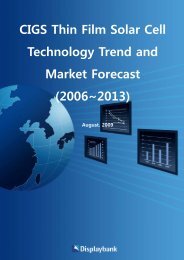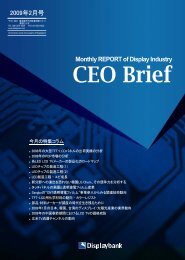Solar Grade-Silicon, Ingot, Wafer Technology and ... - Displaybank
Solar Grade-Silicon, Ingot, Wafer Technology and ... - Displaybank
Solar Grade-Silicon, Ingot, Wafer Technology and ... - Displaybank
You also want an ePaper? Increase the reach of your titles
YUMPU automatically turns print PDFs into web optimized ePapers that Google loves.
<strong>Solar</strong> <strong>Grade</strong>-<strong>Silicon</strong>, <strong>Ingot</strong>,<br />
<strong>Wafer</strong> <strong>Technology</strong> <strong>and</strong> Market Trend<br />
(2008~2012)<br />
Jan 2009<br />
SAMPLE
<strong>Solar</strong> <strong>Grade</strong>-<strong>Silicon</strong>, <strong>Ingot</strong>, <strong>Wafer</strong> <strong>Technology</strong> <strong>and</strong> Market Trend (2008~2012)<br />
<strong>Solar</strong> <strong>Grade</strong>-<strong>Silicon</strong>, <strong>Ingot</strong>,<br />
<strong>Wafer</strong> <strong>Technology</strong> <strong>and</strong> Market Forecast<br />
(2008~2012)<br />
Jan 2009<br />
SAMPLE<br />
<strong>Displaybank</strong> Co., Ltd.<br />
8F 810, Yatap Leaders Bldg. 342-1 Yatap-dong,<br />
Bundang-gu, Seongnam-si, Gyeonggi-do, Korea 463-828<br />
Phone: (82) 31-704-7188, Fax: (82) 31-704-7187<br />
e-mail: Brad@displaybank.com<br />
All Contents of this report remain the property of <strong>Displaybank</strong><br />
Jan’09
<strong>Solar</strong> <strong>Grade</strong>-<strong>Silicon</strong>, <strong>Ingot</strong>, <strong>Wafer</strong> <strong>Technology</strong> <strong>and</strong> Market Trend (2008~2012)<br />
Copyright 2009 <strong>Displaybank</strong> Co., Ltd.<br />
All rights reserved.<br />
No material contained in this report may be reproduced in whole or in part without the express written<br />
permission of <strong>Displaybank</strong> Co., Ltd. This report is intended for the sole <strong>and</strong> exclusive use of the original<br />
purchaser <strong>and</strong> may not be distributed or transferred in any form to any other person or entity.<br />
SAMPLE<br />
<strong>Displaybank</strong> Co., Ltd. provides the information in this report for informational purposes only <strong>and</strong> does not grant<br />
any express or implied warranty, guaranty, or representation concerning the information contained in this<br />
report, its merchantability, or its fitness for a particular purpose or function. Any reference to any specific<br />
commercial product, process, or service by trade name, trademark, manufacturer, or otherwise, does not<br />
necessarily constitute or imply its endorsement, recommendation, or favoring by <strong>Displaybank</strong> Co., Ltd. Neither<br />
<strong>Displaybank</strong> nor any of its affiliates shall be liable to you or any third party in damages of whatever kind that<br />
may result from any reliance on (or use of) any information contained in this report. By receiving this report, you<br />
acknowledge that any reliance on information contained in this report shall be at your sole risk <strong>and</strong> that no<br />
representations have been made to you that are inconsistent with the foregoing.<br />
All Contents of this report remain the property of <strong>Displaybank</strong><br />
Jan’09
<strong>Solar</strong> <strong>Grade</strong>-<strong>Silicon</strong>, <strong>Ingot</strong>, <strong>Wafer</strong> <strong>Technology</strong> <strong>and</strong> Market Trend (2008~2012)<br />
<br />
1. Introduction ....................................................................................................................................<br />
1.1 Renewable Energy <strong>and</strong> Photovoltaic .................................................................................................................<br />
1.2 Low-cost Strategy for <strong>Solar</strong> cell .........................................................................................................................<br />
1.3. Poly-<strong>Silicon</strong> Process ...........................................................................................................................................<br />
2. Poly-<strong>Silicon</strong> Technologies ..............................................................................................................<br />
2.1. Metallurgical <strong>Grade</strong>-<strong>Silicon</strong> (MG-Si) Process .................................................................................................<br />
2.2. <strong>Solar</strong> <strong>Grade</strong>-<strong>Silicon</strong> (SoG-Si) Process ..............................................................................................................<br />
2.3. Current Technologies (Simens Process) ...........................................................................................................<br />
2.3.1 Siemens Process Using TCS (TrichloroSilane)..........................................................................................<br />
2.3.2 Simens Process Using MS (Monosilane).................................................................................................<br />
2.3.3. Hydrogen Reduction Process Using Tetrachlorosilane ...........................................................................<br />
2.4. Alternative Technologies 1 (FBR, VLD, FSR Process) ...............................................................................<br />
2.4.1 Fluidized Bed Reactor (FBR) : MEMC, Wacker, REC etc. .....................................................................<br />
2.4.2 Vapor to Liquid Deposition (VLD) : Tokuyama ......................................................................................<br />
2.4.3 Free Space Reactor (FSR) : Joint <strong>Solar</strong> <strong>Silicon</strong> .......................................................................................<br />
2.5 Alternative Technologies 2 (Metallugical Process) .........................................................................................<br />
2.5.1 Acid Leaching ..........................................................................................................................................<br />
2.5.3 SOLSILC Process (Netherl<strong>and</strong>s, Norway) ..............................................................................................<br />
SAMPLE<br />
2.5.4 UMG-Si Process (Elkem, Norway) .........................................................................................................<br />
2.5.5 Vaccum Refining Process (Kawasaki Steel Corporation, Japan) .............................................................<br />
2.5.6 Dow Corning´s Route - NREL..............................................................................................................<br />
3. <strong>Ingot</strong>/ <strong>Wafer</strong> Process ....................................................................................................................<br />
3.1. <strong>Ingot</strong> Process ....................................................................................................................................................<br />
3.2.1 Czochralski Mehod (CZ) .........................................................................................................................<br />
3.2.2 Floating Zone Method (FZ) .....................................................................................................................<br />
3.3 Multicrystalline <strong>Ingot</strong> .......................................................................................................................................<br />
3.3.1 Block Casting Method ...........................................................................................................................<br />
3.3.2 Electromanetic Casting Process ...............................................................................................................<br />
All Contents of this report remain the property of <strong>Displaybank</strong><br />
Jan’09
<strong>Solar</strong> <strong>Grade</strong>-<strong>Silicon</strong>, <strong>Ingot</strong>, <strong>Wafer</strong> <strong>Technology</strong> <strong>and</strong> Market Trend (2008~2012)<br />
3.4 <strong>Wafer</strong>ing Process ...............................................................................................................................................<br />
3.5 New <strong>Wafer</strong> <strong>Technology</strong> .....................................................................................................................................<br />
3.5.1. Ribbon <strong>Wafer</strong> ................................................................................................................................................<br />
3.5.2. Ribbon <strong>Wafer</strong> (Type I) ............................................................................................................................<br />
3.5.3 Ribbon <strong>Wafer</strong> (Type Ⅱ) ..........................................................................................................................<br />
3.5.4 EFG (Edge-Defined Film Growth, type 1) ..............................................................................................<br />
3.5.5 SR (String Ribbon, type 1) .......................................................................................................................<br />
3.5.6 DW (Dentric Web, type 1) .......................................................................................................................<br />
3.5.7 RGS (Ribbon Growth on Substrate, type 2) .............................................................................................<br />
3.5.8 CDS (Crystallization on Dipped Substrate, type 2) .................................................................................<br />
3.5.9 SSP Ribbon ( <strong>Silicon</strong> sheets from powder ) .............................................................................................<br />
3.6 Thin <strong>Wafer</strong> .........................................................................................................................................................<br />
3.6.1. DFT (Direct Film Transfer) .....................................................................................................................<br />
3.6.2 SLIM (Stress-Induced Lift-off Method) ..................................................................................................<br />
4. Poly-<strong>Silicon</strong> Maker Trend ...........................................................................................................<br />
4.1. Current Producer .............................................................................................................................................<br />
4.1.1. Hemlock Semiconductor Corporations (HSC)........................................................................................<br />
4.1.2. Wacker Chemi .........................................................................................................................................<br />
4.1.3. Renewable Energy Corporation (REC)...................................................................................................<br />
4.1.4. Tokuyama ................................................................................................................................................<br />
4.1.5. Monsanto Electronic Materials Company (MEMC)...............................................................................<br />
4.1.6. Mitsubishi Materials Corporation (MMC) ..............................................................................................<br />
SAMPLE<br />
4.1.7. Sumitomo ................................................................................................................................................<br />
4.2. New Entrants – Current Technologies ...........................................................................................................<br />
4.2.1. Silicium De Provence (SilPro) ................................................................................................................<br />
4.2.3. Other Korean...........................................................................................................................................<br />
4.2.4. Isofóton <strong>and</strong> ENDESA ............................................................................................................................<br />
4.2.5. Hoku Scientific .......................................................................................................................................<br />
4.2.6. M. Setek ..................................................................................................................................................<br />
4.2.7. LDK <strong>Solar</strong> ...............................................................................................................................................<br />
4.2.8. Emei ........................................................................................................................................................<br />
4.2.9. LuoYang China <strong>Silicon</strong> ...........................................................................................................................<br />
4.2.10. Sichuan Xinguang .................................................................................................................................<br />
4.2.11. Nitol <strong>Solar</strong> .............................................................................................................................................<br />
All Contents of this report remain the property of <strong>Displaybank</strong><br />
Jan’09
<strong>Solar</strong> <strong>Grade</strong>-<strong>Silicon</strong>, <strong>Ingot</strong>, <strong>Wafer</strong> <strong>Technology</strong> <strong>and</strong> Market Trend (2008~2012)<br />
4.3. New Entrants-Alternative Technologies .........................................................................................................<br />
4.3.1. Elkem <strong>Solar</strong> ............................................................................................................................................<br />
4.3.2. Joint <strong>Solar</strong> <strong>Silicon</strong> (JSSI)........................................................................................................................<br />
4.3.4. <strong>Solar</strong>value AG .........................................................................................................................................<br />
4.3.5. Dow Corning ..........................................................................................................................................<br />
4.3.6. Bécancour <strong>Silicon</strong> (BSI) .........................................................................................................................<br />
4.3.7. AE Polysilicon ........................................................................................................................................<br />
5. <strong>Ingot</strong>/<strong>Wafer</strong> Producers ................................................................................................................<br />
5.1. PCMP (Podolsky Chemical & Metallurgical Plant) .....................................................................................<br />
5.2. Pillar JSC ..........................................................................................................................................................<br />
5.3. PV Crystalox <strong>Solar</strong> ..........................................................................................................................................<br />
5.4. M. Setek ............................................................................................................................................................<br />
5.5. REC-Sitech, Scanwafer ...................................................................................................................................<br />
5.6. Wacker Shott <strong>Solar</strong> ..........................................................................................................................................<br />
5.7. MEMC ..............................................................................................................................................................<br />
5.8. <strong>Silicon</strong> Ltd (Soetlorodsk).................................................................................................................................<br />
5.9. Swiss <strong>Wafer</strong> ......................................................................................................................................................<br />
5.10. <strong>Solar</strong> World ....................................................................................................................................................<br />
5.11. Kyocera ...........................................................................................................................................................<br />
5.12. ASi Industries GmbH ....................................................................................................................................<br />
SAMPLE<br />
6. Poly-<strong>Silicon</strong> Market Forecast (2007~2012) ................................................................................<br />
6.1. Poly-<strong>Silicon</strong> Production & Capacity .............................................................................................................<br />
6.2. Poly-Silion supply & Dem<strong>and</strong> forecast for solar cell ....................................................................................<br />
6.3. Poly-<strong>Silicon</strong> Production & Capacity by company .........................................................................................<br />
6.4. Poly-<strong>Silicon</strong> Price (Contract, Spot) .................................................................................................................<br />
6.5. Poly-<strong>Silicon</strong> Revenue forecast (<strong>Solar</strong>) ............................................................................................................<br />
6.6. Poly-silicon Production Cost by <strong>Technology</strong> ..................................................................................................<br />
6.7. Poly-<strong>Silicon</strong> Capacity by Region .....................................................................................................................<br />
6.8. Poly-<strong>Silicon</strong> Production Forecast by Region .................................................................................................<br />
All Contents of this report remain the property of <strong>Displaybank</strong><br />
Jan’09
<strong>Solar</strong> <strong>Grade</strong>-<strong>Silicon</strong>, <strong>Ingot</strong>, <strong>Wafer</strong> <strong>Technology</strong> <strong>and</strong> Market Trend (2008~2012)<br />
6.9. Poly-<strong>Silicon</strong> production by technology ...........................................................................................................<br />
6.10. UMG-Si ...........................................................................................................................................................<br />
6.11. <strong>Ingot</strong>/<strong>Wafer</strong> Production .................................................................................................................................<br />
6.12. <strong>Wafer</strong> Revenue ...............................................................................................................................................<br />
7. Reference List ...............................................................................................................................<br />
8. Index ..............................................................................................................................................<br />
8.1. Table ..................................................................................................................................................................<br />
8.2. Figure ................................................................................................................................................................<br />
SAMPLE<br />
All Contents of this report remain the property of <strong>Displaybank</strong><br />
Jan’09
<strong>Solar</strong> <strong>Grade</strong>-<strong>Silicon</strong>, <strong>Ingot</strong>, <strong>Wafer</strong> <strong>Technology</strong> <strong>and</strong> Market Trend (2008~2012)<br />
1.3. Poly-silicon Process<br />
The solar grade-silicon <strong>and</strong> its wafer manufacturing technology can be<br />
summarized like the figure below. The process starts with metallurgical silicon,<br />
MG-Si, which has about 99% purity <strong>and</strong> undergoes gasification <strong>and</strong><br />
purification processes to obtain silane gas. The silane gas is extracted at high<br />
temperature to obtain solar grade-silicon, SoG-Si. The solar grade-silicon<br />
manufacturing process includes Siemens, FBR, <strong>and</strong> VLD methods. Details of<br />
these methods will be discussed in the following chapter.<br />
Figure 1.3.1. <strong>Silicon</strong> <strong>Solar</strong> Cell Manufacturing Process<br />
SAMPLE<br />
The silicon obtained from the above process is categorized into chip (chunk),<br />
granular, <strong>and</strong> powder (dust-like) shapes upon the manufacturing method. The<br />
silicon is melt again to produce ingot. Czochralski, CZ, method is used to<br />
manufacture monocrystalline ingot <strong>and</strong> heating furnace is used to manufacture<br />
multicrystalline ingot blocks. The monocrystalline ingot has limited diameter<br />
since it grow crystal vertically <strong>and</strong> needs to cut edges to produce rectangular<br />
wafers that its final wafer size is smaller than the one of multicrystalline ingot<br />
method. Currently, the maximum size of the monocrystalline silicon wafer is<br />
156 x 156mm.<br />
The solar grade-silicon must satisfy physical property requirements like the<br />
following. First requirement is the size of poly-silicon. The size is an extremely<br />
All Contents of this report remain the property of <strong>Displaybank</strong><br />
Jan’09
<strong>Solar</strong> <strong>Grade</strong>-<strong>Silicon</strong>, <strong>Ingot</strong>, <strong>Wafer</strong> <strong>Technology</strong> <strong>and</strong> Market Trend (2008~2012)<br />
important factor in determining silicon’s quality <strong>and</strong> unit cost. The poly-silicon<br />
is categorized into powder (dust-like) type which is smaller than several tens of<br />
um, granular type with several mm, <strong>and</strong> chunk (chip) type which is greater<br />
than several cm.<br />
For instance, the dust-like type manufactured by so-called free space method<br />
has the most effect on manufacturing cost cut among chemical methods using<br />
gas reactions. On the other h<strong>and</strong>, it has a shortcoming that it is difficult to<br />
regulate processes while melting silicon to grow crystals, which is a<br />
subsequent process, due to large specific surface areas <strong>and</strong> low density.<br />
Hence, the granular or chunk types appear proper considering subsequent<br />
processes. The granular type poly-silicon has a high filling density of crucible<br />
during crystal growth <strong>and</strong> enables continuous processes through fixed supply,<br />
but it also has large specific surface areas that it is difficult to h<strong>and</strong>le since it is<br />
easily contaminated by external environments. The poly-silicon manufactured<br />
by Siemens method is mostly chunk type. This type is easy to h<strong>and</strong>le in<br />
process, but has a low crucible filling density.<br />
The most important physical property of the poly-silicon is purity. The<br />
concentration of impurities within the poly-silicon has the biggest effect on the<br />
efficiency of solar cells <strong>and</strong> is the most critical variation in determining<br />
SAMPLE<br />
manufacturing costs. Impurities included within the silicon interior are generally<br />
divided into metal impurities <strong>and</strong> non-metal impurities. Major metal impurities<br />
include Fe, Al, Ti, Ca, Na, Zn, <strong>and</strong> Cu. Their inclusions may vary upon the<br />
initial silica materials <strong>and</strong> metallurgical silicon manufacturing processes. The<br />
poly-silicon must only include less than 1ppba metal impurities like the figure<br />
below in order to be used in solar cells.<br />
The second method creates trichlorosilane through metallurgical silicon <strong>and</strong><br />
hydrogenation processes.<br />
All Contents of this report remain the property of <strong>Displaybank</strong><br />
Jan’09
<strong>Solar</strong> <strong>Grade</strong>-<strong>Silicon</strong>, <strong>Ingot</strong>, <strong>Wafer</strong> <strong>Technology</strong> <strong>and</strong> Market Trend (2008~2012)<br />
3SiCl 4 + 2H 2 + Si = 4SiHCl 3<br />
This process spills mixture of tetrachlorosilane <strong>and</strong> hydrogen to the<br />
metallurgical silicon within a fluidized reactor usually at 500°C <strong>and</strong> 35 bars <strong>and</strong><br />
obtains trichlorosilane.<br />
Figure 2.10. Interior of Siemens Reactor<br />
The Siemens process has rather poor energy efficiency; it consumes a large<br />
amount of electricity to maintain extraction temperature at higher than 1,000℃<br />
during the process <strong>and</strong> has a great loss in amount of heat while continuously<br />
cooling down interior walls with circulating coolants to prevent Si extractions.<br />
Usually, it loses more than 90% of energy input in exterior cooling walls. The<br />
Siemens methods consumes about 60~150kWh in manufacturing 1 kg of<br />
SoG-Si. Hence, it installs several bars within the Siemens reactor in order to<br />
enhance the low efficiency (refer to figure 2.11).<br />
SAMPLE<br />
All Contents of this report remain the property of <strong>Displaybank</strong><br />
Jan’09
<strong>Solar</strong> <strong>Grade</strong>-<strong>Silicon</strong>, <strong>Ingot</strong>, <strong>Wafer</strong> <strong>Technology</strong> <strong>and</strong> Market Trend (2008~2012)<br />
2.4.2 Vapor to Liquid Deposition (VLD): Tokuyama<br />
VLD method produces trichlorosilane or monosilane gasses by reacting<br />
metallic silicon with either hydrochloric acid or hydrogen, <strong>and</strong> then produces<br />
liquid silicon directly from the gas. It is similar to the Siemens process in using<br />
trichlorosilane gasses, but it obtains liquid silicon as the gas undergoes a tubeshaped<br />
reactor with inductive heating to be restored.<br />
Figure 2.4.2 VLD Method Concept<br />
Source: Tokuyama<br />
Hence, VLD method has outst<strong>and</strong>ing efficiency <strong>and</strong> productivity. It has<br />
extraction speed 10 times faster than the conventional Siemens process, but<br />
is difficult to delete impurities. The Siemens process starts with obtaining<br />
semiconductor silicon with ultra high purity <strong>and</strong> is applied to the solar gradesilicon<br />
production by lowering the quality <strong>and</strong> enhancing the productivity. On<br />
the other h<strong>and</strong>, VLD process is suitable for the solar grade-silicon production<br />
which requires relatively lower quality <strong>and</strong> high productivity. The VLD process<br />
is currently known to be developed by Tokuyama, but has difficulties in terms<br />
of yield. Its energy efficiency is more than 5 times higher than the Siemens<br />
process.SAMPLE<br />
All Contents of this report remain the property of <strong>Displaybank</strong><br />
Jan’09
<strong>Solar</strong> <strong>Grade</strong>-<strong>Silicon</strong>, <strong>Ingot</strong>, <strong>Wafer</strong> <strong>Technology</strong> <strong>and</strong> Market Trend (2008~2012)<br />
Figure 2.19. Tube Reactor in Joint <strong>Solar</strong> <strong>Silicon</strong> (JSSi) Process<br />
Source: Joint <strong>Solar</strong> <strong>Silicon</strong><br />
The traditional Siemens process decomposes silane in silicon seed (U-rod),<br />
whereas the Joint <strong>Solar</strong> <strong>Silicon</strong> reactor decomposes silane in reactor’s interior<br />
space that it is called “free space reactor method”. The method supplies<br />
hydrogen <strong>and</strong> silane to the reactor’s interior <strong>and</strong> enters heat to walls to<br />
decompose silane away from the walls. Like in the Siemens process, the free<br />
space reactor method does not require equipments for silicon seed preheating<br />
<strong>and</strong> is able to prevent pollutions from graphite which composes the preheating<br />
equipments. The method uses monosilane rather than chlorosilane for raw<br />
materials because the monosilane enables low temperature processes <strong>and</strong><br />
decomposes well that it converts gasses to silicon in reactors with single<br />
process. However, the monosilane may possibly explode when it is in contact<br />
with oxygen that reactors must be designed carefully to prevent such outcome.<br />
It is also more expensive than trichlorosilane. The thermal decomposition<br />
reaction of silane is like the following.<br />
SiH 4 -> SiH 2 +H 2<br />
SiH 2 + SiH 4 –> Si 2 H 6<br />
SiH 2 +Si 2 H 6 -> Si 3 H 8<br />
The silicon powder manufactured through reactors undergoes high density<br />
process for easy h<strong>and</strong>ling, delivery, <strong>and</strong> loading. Here, the density increases<br />
from 50g/L to 500g/L. The figure below shows silicon powder that finished the<br />
high density process. The powder is melted <strong>and</strong> produced into ingot to be<br />
manufactured into final products.<br />
SAMPLE<br />
All Contents of this report remain the property of <strong>Displaybank</strong><br />
Jan’09
<strong>Solar</strong> <strong>Grade</strong>-<strong>Silicon</strong>, <strong>Ingot</strong>, <strong>Wafer</strong> <strong>Technology</strong> <strong>and</strong> Market Trend (2008~2012)<br />
Figure 2.5.1 Impurities in MG-Si: Equilibrium Distribution Coefficient<br />
Most impurities, except for phosphorus, boron, <strong>and</strong> carbon, have extremely<br />
small equilibrium distribution coefficient. This indicates that the impurities are<br />
concentrated in liquid phase silicon rather than in solid phase silicon in mushy<br />
zone. Hence, impurities tend to concentrate in areas where they are solidified<br />
at last.<br />
As shown in the figure below, impurities show the maximum solubility near<br />
melting point <strong>and</strong> the solubility radically declines as temperature drops. Hence,<br />
the metal impurities that exceed solubility during solidification processes are<br />
efficiently extracted through crystal boundaries or cracks in general. <strong>Silicon</strong> is<br />
insoluble to acids, whereas the metal impurities dissolve well in acids. Pickling<br />
process selectively eliminates the extracted metal impurities with acid.<br />
Figure 2.5.2 Metal Impurities Employment within <strong>Silicon</strong><br />
SAMPLE<br />
All Contents of this report remain the property of <strong>Displaybank</strong><br />
Jan’09
<strong>Solar</strong> <strong>Grade</strong>-<strong>Silicon</strong>, <strong>Ingot</strong>, <strong>Wafer</strong> <strong>Technology</strong> <strong>and</strong> Market Trend (2008~2012)<br />
3.2.2 Floating Zone Method (FZ)<br />
Floating zone method was developed by Keck <strong>and</strong> others in 1952. It manufactures<br />
silicon with the highest purity. Its basic principle includes partially melting long bar to<br />
produce liquid phase region. It moves the region following after the bar to grow<br />
monocrystal. Most impurities within silicon usually have equilibrium distribution<br />
coefficient less than 1 that the impurities are separated in the liquid phase region with<br />
CO/K concentration. The liquid phase region is cornered to move impurities towards<br />
the end of the bar simultaneously.<br />
Figure 3.2.3. Floating Zone Method Equipment<br />
SAMPLE<br />
As shown in the figure, the FZ method has no parts in contact with silicon<br />
liquid unlike the CZ method that it can fundamentally prevent pollutions from<br />
crucibles <strong>and</strong> obtain silicon with high quality. On the other h<strong>and</strong>, it requires a<br />
liquid phase to remain in-between solid phases as a surface tension that it has<br />
a limitation in a diameter of ingot to be manufactured. The method is generally<br />
used to manufacture silicon bars of several tens of mm. The maximum<br />
diameter of ingot using the currently developed floating zone method is about<br />
150 mm. Therefore, the FZ method is improper to be used commercially due<br />
to low productivity. Instead, it is used in special occasions when silicon with<br />
high purity is needed.<br />
All Contents of this report remain the property of <strong>Displaybank</strong><br />
Jan’09
<strong>Solar</strong> <strong>Grade</strong>-<strong>Silicon</strong>, <strong>Ingot</strong>, <strong>Wafer</strong> <strong>Technology</strong> <strong>and</strong> Market Trend (2008~2012)<br />
Figure 3.3.5. Comparison between Conventional Solidification Process <strong>and</strong> Electromagnetic<br />
Casting Method<br />
Unlike the ingot obtained by cooling in the conventional graphite crucible or a quartz<br />
crucible located within the graphite crucible, the FZ method obtains silicon with high<br />
quality by minimizing contacts with crucibles <strong>and</strong> hence preventing pollutions from the<br />
crucibles. Moreover, it enhances productivity by reducing replacement expenses spent<br />
in crucibles, which are disposed after a single or few uses, <strong>and</strong> enabling continuous<br />
operations (productivity in same time frame is about 5 times higher than HEM method<br />
<strong>and</strong> 7 to 15 times higher than Czochralski method). However, this technology has a<br />
difficulty in silicon application. <strong>Silicon</strong> has difficult electromagnetic induction due to low<br />
SAMPLE<br />
electric conductivity in solid phase. It is also difficult to expect processes with high<br />
efficiency since it melts silicon with high latent heat <strong>and</strong> melting point in water-cooling<br />
crucibles <strong>and</strong> loses a lot of heat. Therefore, the industry conducts research studies in<br />
order to resolve such issues <strong>and</strong> the method is sometime used in combination with the<br />
conventional refining process like the figure below. The figure shows a method that<br />
melts silicon through plasma melting to create liquid phase <strong>and</strong> enters it to a crucible.<br />
<strong>Silicon</strong> mostly displays nonconductive property in solid phase, but shows conductive<br />
property in liquid phase.<br />
All Contents of this report remain the property of <strong>Displaybank</strong><br />
Jan’09
<strong>Solar</strong> <strong>Grade</strong>-<strong>Silicon</strong>, <strong>Ingot</strong>, <strong>Wafer</strong> <strong>Technology</strong> <strong>and</strong> Market Trend (2008~2012)<br />
Figure 3.5.3. Post-Annealing Method for Temperature Stress Reduction (EFG Method)<br />
SAMPLE<br />
All Contents of this report remain the property of <strong>Displaybank</strong><br />
Jan’09
<strong>Solar</strong> <strong>Grade</strong>-<strong>Silicon</strong>, <strong>Ingot</strong>, <strong>Wafer</strong> <strong>Technology</strong> <strong>and</strong> Market Trend (2008~2012)<br />
3.5.3 Ribbon <strong>Wafer</strong> (Type Ⅱ)<br />
This method instantly deletes latent heat, which is generated on mushy<br />
interface during solidification of silicon, though cold substrates touching the<br />
silicon. Unlike the type I that deletes latent heat with radiant heat of solidified<br />
ribbon itself, the type II moves heat through large area substrates that it<br />
efficiently deletes latent heat, hence grows ribbon fast. The maximum speed to<br />
grow ribbon, Vp, is as follows.<br />
“a” is a valid heat delivery coefficient, “s” is a mushy interface area in a<br />
direction of ribbon growth, <strong>and</strong> “ T" is a temperature difference between liquid<br />
phase silicon <strong>and</strong> substrate. According to the equation, the maximum speed to<br />
grow ribbon is 600cm/sec when T is 160 o C. It rapidly creates ribbon by<br />
efficiently deleting the latent heat <strong>and</strong> has high productivity. However, it grows<br />
crystal starting from areas touching substrates that it has relatively smaller<br />
crystal structure with chaotic direction compared to the type II method. The<br />
type II method grows crystals at irregular speed which varies upon time. It has<br />
a fast crystal growing speed at initial solidification phases where liquid phase<br />
silicon touch substrates directly, but the speed slows down once ribbons are<br />
created because the latent heat generated from the mushy interface<br />
undergoes the created ribbon thickness <strong>and</strong> exits towards substrates. It is<br />
expressed in the following equation. “s(t)” is a location of mushy interface upon<br />
time.<br />
SAMPLE<br />
All Contents of this report remain the property of <strong>Displaybank</strong><br />
Jan’09
<strong>Solar</strong> <strong>Grade</strong>-<strong>Silicon</strong>, <strong>Ingot</strong>, <strong>Wafer</strong> <strong>Technology</strong> <strong>and</strong> Market Trend (2008~2012)<br />
4.1.3. Renewable Energy Corporation (REC)<br />
REC was newly established in the 90’s in Norway. It is a child company of<br />
Fornybar Energi AS from 1996 <strong>and</strong> has been focusing on renewable energy<br />
field. REC was found by merging Scanwafer AS, SolEnergy AS, <strong>and</strong> Fornybar<br />
Energi AS in November 2000. REC secures an idealistic corporate structure<br />
with completed vertical integrations in all fields of solar cell value chain,<br />
including poly-silicon, substrate, cell, module, installation, <strong>and</strong> drive, through<br />
its child companies like REC <strong>Silicon</strong>, REC <strong>Wafer</strong>, <strong>and</strong> REC <strong>Solar</strong>.<br />
Figure4.1.5. Vertically Integrated <strong>Solar</strong> Cell Business Structure of REC<br />
Source: REC<br />
SAMPLE<br />
REC manufactures about 6,150M/T in 2008 <strong>and</strong> seems possible to<br />
manufacture up to about 12,400M/T in 2009. It signed a long-term contract<br />
with Neo<strong>Solar</strong> Power from Taiwan to supply poly-silicon of about USD 450<br />
million worth until 2015. It also announced to construct additional monosilane<br />
production line in Singapore in 2007 to secure monosilane production of<br />
maximum 2,300M/T per year. Unlike other companies, REC used monosilane<br />
gas as raw materials to secure its own technology. It also solitarily developed<br />
closed-loop method...<br />
All Contents of this report remain the property of <strong>Displaybank</strong><br />
Jan’09
<strong>Solar</strong> <strong>Grade</strong>-<strong>Silicon</strong>, <strong>Ingot</strong>, <strong>Wafer</strong> <strong>Technology</strong> <strong>and</strong> Market Trend (2008~2012)<br />
4.2.7. LDK <strong>Solar</strong><br />
LDK <strong>Solar</strong> is a large silicon wafer maker. LDK purchased most of poly-silicon<br />
manufacturing technology <strong>and</strong> equipment from overseas <strong>and</strong> applied in<br />
production. It manufactures from poly-silicon to wafer. Its production base for<br />
solar grade-wafer is located in Xinyu, China. It is constructing a factory to<br />
annually produce 14,000 tons of poly-silicon through its child company, Jiangxi<br />
Poly<strong>Silicon</strong>. It uses Siemens method to manufacture poly-silicon. Fluor from<br />
the U.S. is in charge of the factory design, construction, <strong>and</strong> management. GT<br />
<strong>Solar</strong> from the U.S. is in charge of reactors <strong>and</strong> LXE <strong>Solar</strong> <strong>and</strong> CDI<br />
Engineering Solutions are in charge of trichlorosilane supply. Fluor is known to<br />
have invested total of USD 1.2 billion, which includes USD 1 billion for down<br />
payment, to the construction by Jiangxi Polysilicon. The poly-silicon factory by<br />
Jiangxi PV <strong>Silicon</strong> Hi-Tech was expected to be completed in June 2008 <strong>and</strong><br />
was scheduled to receive 400 tons of trichlorosilane per month from Jiangxi<br />
Ganzhong Chlorine & Caustic starting in May 2008. Sunways signed a<br />
contract to supply reactors to LDK <strong>and</strong> receive poly-silicon supplies from LDK.<br />
In addition, Jiangxi Poly<strong>Silicon</strong> independently manufactures trichlorosilane <strong>and</strong><br />
its production capacity is 90,000 ton/yr.<br />
Figure4.9. <strong>Solar</strong> Cell p-Si Manufactured by LDK<br />
Source: LDK<br />
SAMPLE<br />
All Contents of this report remain the property of <strong>Displaybank</strong><br />
Jan’09
<strong>Solar</strong> <strong>Grade</strong>-<strong>Silicon</strong>, <strong>Ingot</strong>, <strong>Wafer</strong> <strong>Technology</strong> <strong>and</strong> Market Trend (2008~2012)<br />
6.2. p-Si supply & Dem<strong>and</strong> forecast for solar cell<br />
The solar cell market recorded more than 40% average annual growth rate<br />
from 2007 to 3Q 2008 due to support policies by each nation’s government<br />
<strong>and</strong> the importance of PV business with global recognition in environmental<br />
issues. Such high growth rate resulted in shortages of poly-silicon, a raw<br />
material for crystalline solar cell. The spot price of short-term contract even<br />
went up to US$400/Kg. Numerous companies announce their plans to join the<br />
poly-silicon business which shows high earning rate.<br />
The figure below is data collected by analyzing 80 new entrants including the 7<br />
major global p-Si makers. It forecasts solar grade-silicon supply by three<br />
scenarios. The p-Si supply is projected to exceed dem<strong>and</strong> starting in 2009 <strong>and</strong><br />
record the highest supply surplus in 2010.<br />
However, the large-scale investments by the new entrants are likely to be<br />
delayed due to the global economic slump from 2009 to the first half of 2010. If<br />
the conventional p-Si maker’s production cuts are added here, it may create a<br />
reversed situation of the raw material shortages starting in 2011, after the<br />
supply surplus for a short period of time (2009 to 2010), like Scenario 2.<br />
Hence, the advanced conventional makers focus in product differentiation by<br />
enhancing quality <strong>and</strong> purity. They propel strategies to maintain a stable p-Si<br />
price.<br />
Figure6.2. <strong>Solar</strong> Cell p-Si Dem<strong>and</strong>/Supply Forecast<br />
MW<br />
40,000<br />
35,000<br />
30,000<br />
25,000<br />
20,000<br />
15,000<br />
SAMPLE<br />
Cell Dem<strong>and</strong> (MW)<br />
Supply (MW, S1)<br />
Supply (MW, S2: Base)<br />
Supply (MW, S3)<br />
10,000<br />
5,000<br />
0<br />
2007 2008 2009F 2010F 2011F 2012F<br />
All Contents of this report remain the property of <strong>Displaybank</strong><br />
Jan’09
<strong>Solar</strong> <strong>Grade</strong>-<strong>Silicon</strong>, <strong>Ingot</strong>, <strong>Wafer</strong> <strong>Technology</strong> <strong>and</strong> Market Trend (2008~2012)<br />
6.3. p-Si Production & Capacity by company<br />
The table below shows production <strong>and</strong> capacity by group <strong>and</strong> maker. Each<br />
data is combined value of solar p-Si <strong>and</strong> electronics p-Si.<br />
Table 6.3. p-Si Production & Capacity by Company<br />
.<br />
Group<br />
Group 1<br />
Group 2<br />
Company Name<br />
Hemlock<br />
Wacker<br />
REC SGS (Moses Lake)<br />
Tokuyama<br />
MEMC Pasadena<br />
REC Asimi (Butte)<br />
MEMC Merano<br />
Mitsubishi Material<br />
Mitsubishi Polysilicon<br />
Osaka Titanium (Sumitomo Titanium)<br />
Group 1 Total<br />
Production<br />
Capacity<br />
2007 2008 2009 2010 2011 2012<br />
SAMPLE<br />
All Contents of this report remain the property of <strong>Displaybank</strong><br />
Jan’09
<strong>Solar</strong> <strong>Grade</strong>-<strong>Silicon</strong>, <strong>Ingot</strong>, <strong>Wafer</strong> <strong>Technology</strong> <strong>and</strong> Market Trend (2008~2012)<br />
Group 3<br />
Group 2 Total<br />
SAMPLE<br />
Others in Group 3<br />
Group 3 Total<br />
Group 4(Others) Total<br />
All Contents of this report remain the property of <strong>Displaybank</strong><br />
Jan’09
<strong>Solar</strong> <strong>Grade</strong>-<strong>Silicon</strong>, <strong>Ingot</strong>, <strong>Wafer</strong> <strong>Technology</strong> <strong>and</strong> Market Trend (2008~2012)<br />
8. Index<br />
8.1. Table<br />
Table 1.1.1 Reneable Energy Investment <strong>and</strong> Generation Unit Cost ..........................................................................<br />
Table 2.1.1. Purity of Utilized Raw Materials by Carbo Process .............................................................................<br />
Table 2.1.2. Utilized Raw Material by Direct Reduction Project................................................................................<br />
Table 2.3.1.1 Characteristic of Siemens Method ......................................................................................................<br />
Table 2.3.1.1 Comparison of TCS-based Siemans <strong>and</strong> MS-based Siemens .............................................................<br />
Table 3-1. Property Comparison by <strong>Silicon</strong> <strong>Ingot</strong> Growth <strong>Technology</strong> ....................................................................<br />
Table 3.5.1. Manufacturing Unit Cost by <strong>Solar</strong> Cell Process (%) .............................................................................<br />
Table 3.5.2. Ribbon Growth Method Comparison ....................................................................................................<br />
Table 3.5.3.Property Comparison by Ribbon <strong>Technology</strong> ........................................................................................<br />
Table 4.2.1. Presented by DC Chemical ...................................................................................................................<br />
Table 4.2.2. p-Si Plant Construction Project Status of LuoYang ZhongGui .............................................................<br />
Table 4.2.3. Long-Terrn p-Si Supply Contract Status of Nitol <strong>Solar</strong> ........................................................................<br />
Table 4.3.1. Impurities Concentration of Bécancour <strong>Silicon</strong> UMG-Si .....................................................................<br />
Table 5.1. Monocrystalline <strong>Silicon</strong> Portfolio Manufactured by Podolsk ..................................................................<br />
Table 5.2. Monocrystalline <strong>Silicon</strong> <strong>Solar</strong> Cell Portfolio Manufactured by Podolsk .................................................<br />
Table 5.3. <strong>Solar</strong> Cell <strong>Wafer</strong> St<strong>and</strong>ared Manufactured by Pillar JSC .........................................................................<br />
Table 5.4. Kyocera’s Expansion Plan........................................................................................................................<br />
Table 6.1. p-Si production & Capacity by Section .....................................................................................................<br />
Table 6.2. <strong>Solar</strong> Cell p-Si Dem<strong>and</strong>/Supply Forecast ..................................................................................................<br />
Table 6.3. p-Si Production & Capacity by Company ................................................................................................<br />
Table 6.4. p-Si Price Forecast ($/Kg).........................................................................................................................<br />
Table 6.5. p-Si Revenue .............................................................................................................................................<br />
SAMPLE<br />
Table 6. 6. Manufacturing Cost Ratio by Method ($/Kg) ..........................................................................................<br />
Table 6.7. poly-<strong>Silicon</strong> Capacity by Region ..............................................................................................................<br />
Table 6.8. poly-<strong>Silicon</strong> Production Forecast by Region.............................................................................................<br />
Table 6.10. UMG-Si Capacity by Company ..............................................................................................................<br />
Table 6.11. <strong>Ingot</strong>/<strong>Wafer</strong> Production ...........................................................................................................................<br />
Table 6.12. <strong>Wafer</strong> Revenue ........................................................................................................................................<br />
All Contents of this report remain the property of <strong>Displaybank</strong><br />
Jan’09
<strong>Solar</strong> <strong>Grade</strong>-<strong>Silicon</strong>, <strong>Ingot</strong>, <strong>Wafer</strong> <strong>Technology</strong> <strong>and</strong> Market Trend (2008~2012)<br />
8.2. Figure<br />
Figure 1.1.1 Long-Term Forecast of Power Generation Volume by Global Energy Source .......................................<br />
Figure 1.1.2 Potential Energy Volume of the Earth ....................................................................................................<br />
Figure 1.1.3 Types of <strong>Solar</strong> Cell .................................................................................................................................<br />
Figure 1.1.4. Rouch Comparison of Generation Unit Cost by Power Source .............................................................<br />
Figure 1.1.5. Module Manufacturing Unit Cost upon Cell Efficiency ........................................................................<br />
Figure 1.1.6. Composition Ratio of <strong>Solar</strong> Cell Manufacturing Unit Cost ...................................................................<br />
Figure 1.1.7 <strong>Wafer</strong> <strong>and</strong> Module Manufacturing Unit Cost upon p-Si Manufacturing 1 Unit Cost .............................<br />
Figure 1.2.1. <strong>Silicon</strong> <strong>Solar</strong> Cell Value Chain ..............................................................................................................<br />
Figure 1.2.2. <strong>Technology</strong> Direction for Inexpensive <strong>Solar</strong> Cell Material ...................................................................<br />
Figure 1.3.1. <strong>Silicon</strong> <strong>Solar</strong> Cell Manufacturing Process .............................................................................................<br />
Figure 1.3.2. Monocrystalline <strong>Ingot</strong> Manufacturing Process ......................................................................................<br />
Figure 1.3.3. Polycrystalline <strong>Silicon</strong> <strong>Wafer</strong> Manufacturing Process ...........................................................................<br />
Figure 2.1. Market Share <strong>and</strong> Forecast of p-Si Manufacturing <strong>Technology</strong> ...............................................................<br />
Figure 2.2. Metal Impurity Concentration Limit of <strong>Solar</strong> Cell p-Si ...........................................................................<br />
Figure 2.3. Nonmetal Impurity Concentration Limit of <strong>Solar</strong> Cell p-Si .....................................................................<br />
Figure 2.1.1. MG <strong>Silicon</strong> Manufacturing Process (Elkem).........................................................................................<br />
Figure 2.1.2. SiO Equilibrium Vapor Pressure upon Temperature ..............................................................................<br />
Figure 2.1.3 Achro Used in <strong>Silicon</strong> Reduction (ECN)................................................................................................<br />
Figure 2.1.4. Carbothermic Reduction (ECN) ............................................................................................................<br />
Figure 2.2.1. Environmental Variatios Need to be Considered in Each Process .........................................................<br />
Figure 2.9. Basic Structure of Bell-jar Reactor Used in Siemens Method ..................................................................<br />
Figure 2.10. Interior of Siemens Reactor ..................................................................................................................<br />
Figure 2.11. U-Bar Arragement Inside of Siemens Reactor ......................................................................................<br />
Figure 2.12. <strong>Silicon</strong> U-Bar Manufactured by Siemens Method ................................................................................<br />
SAMPLE<br />
Figure 2.13. <strong>Silicon</strong> Chunk Obrained by Pulverizing <strong>Silicon</strong> U-Bar ........................................................................<br />
Figure 2.3.2.1 Deposition Principle of TCS-based <strong>and</strong> MS-based ...........................................................................<br />
Figure 2.4.1 Fluidized Bed Reactor ..........................................................................................................................<br />
Figure 2.4.2 VLD Method Concept ..........................................................................................................................<br />
Figure 2.4.3 <strong>Silicon</strong> Production Plant in Tokuyaman Using VLD Method ..............................................................<br />
Figure 2.4.4 Property of <strong>Ingot</strong> Refined Using VLD Method ....................................................................................<br />
Figure 2.19. Tube Reactor in Joint <strong>Solar</strong> <strong>Silicon</strong> (JSSi) Process ..............................................................................<br />
Figure 2.20. <strong>Silicon</strong> Underwent High-Density Process ............................................................................................<br />
Figure 2.5.1 Impurities in MG-Si: Equilibrium Distribution Coefficient .................................................................<br />
Figure 2.5.2 Metal Impurities Employment within <strong>Silicon</strong> ......................................................................................<br />
Figure 2.5.3 Acid Leaching Process Outline .............................................................................................................<br />
Figure 2.5.4. SOLSILC Project Structure Map .........................................................................................................<br />
All Contents of this report remain the property of <strong>Displaybank</strong><br />
Jan’09
<strong>Solar</strong> <strong>Grade</strong>-<strong>Silicon</strong>, <strong>Ingot</strong>, <strong>Wafer</strong> <strong>Technology</strong> <strong>and</strong> Market Trend (2008~2012)<br />
Figure 2.5.5. SOLSILC Process Outline ...................................................................................................................<br />
Figure 2.5.6. 100 kW Pilot Arc Furnace <strong>and</strong> Eduction Process ................................................................................<br />
Figure 2.5.7.Crystalox furnace (SINTEF) for Directional Solidification .................................................................<br />
Figure 2.28. Elkem Process Outline .........................................................................................................................<br />
Figure 2.29. μ-PCD Lifetime Estimation of <strong>Wafer</strong> Manufactured with p-Si Mixed with 0, 33, 50, <strong>and</strong> 100 %<br />
of Elkem’s UMG-Si to Conventional p-Si ................................................................................................................<br />
Figure 2.30. Efficiency of <strong>Solar</strong> Cell Manufactured by Mixing Conventioanl <strong>Silicon</strong> with UMG-Si ......................<br />
Figure 2.5.9. Kawasaki Steel <strong>Silicon</strong> Refining Process ............................................................................................<br />
Figure 2.5.10. Kawasaki Steel <strong>Silicon</strong> Refining Process Map ..................................................................................<br />
Figure 2.5.11. Phosphorus Deletion Ratio in Electron beam Refining Process ........................................................<br />
Figure 2.5.12. 1st Impurities Distribution of <strong>Ingot</strong> with Completed Directional Solidification ...............................<br />
Figure 2.5.13. Boron Deletion in Plasma Process upon Hydrogen <strong>and</strong> Vapor Addition ...........................................<br />
Figure 2.5.14. Vapor Pressure Curve by Element upon Temperature .......................................................................<br />
Figure 2.5.15. NREL Process Outline (modified HEM) ...........................................................................................<br />
Figure 2.5.16. Modified HEM Reactor of Bench Scale ............................................................................................<br />
Figure 2.5.17. HEM amd 60kg <strong>Silicon</strong> <strong>Ingot</strong> Used in NREL Experiment ................................................................<br />
Figure 3.1. Cell <strong>Technology</strong> Shares ..........................................................................................................................<br />
Figure 3.2.1. Czochralski Growth Equipment ..........................................................................................................<br />
Figure 3.2.2. Monocrystalline <strong>Ingot</strong> Manufacturing Process through Czochraliski Growth .................................<br />
Figure 3.2.3. <strong>Ingot</strong> Diameter Change upon Czochralski Growth Speed ...................................................................<br />
Figure 3.2.3. Floating Zone Method Equipment .......................................................................................................<br />
Figure 3.3.1. Polycrystalline <strong>Ingot</strong> Manufacturing Method ......................................................................................<br />
Figure 3.9. Dislocation Defect Distribution <strong>and</strong> Efficiency Distribution .................................................................<br />
Figure 3.10. p-Si Manufactured by Block Casting Method ......................................................................................<br />
Figure 3.3.4. Electromagnetic Continuous Casting Method ..................................................................................<br />
Figure 3.3.5. Comparison between Conventional Solidification Process <strong>and</strong> Electromagnetic Casting Method .....<br />
SAMPLE<br />
Figure 3.3.6. Plasma Refining Process Using Electromagnetic Casting Method .....................................................<br />
Figure 3.14. <strong>Solar</strong> Cell <strong>Wafer</strong> Manufacturing Process ..............................................................................................<br />
Figure 3.15. <strong>Silicon</strong> <strong>Wafer</strong> Manufacturing Process <strong>and</strong> Cut Loss ............................................................................<br />
Figure 3.16. Polycrystalline <strong>Silicon</strong> Blocking Process .............................................................................................<br />
Figure 3.17. <strong>Silicon</strong> <strong>Ingot</strong> Sawing Process <strong>and</strong> Loss Ratio by Process ....................................................................<br />
Figure 3.18. <strong>Silicon</strong> Block Cut Process ....................................................................................................................<br />
Figure 3.19. Polycrystalline <strong>Silicon</strong> Block after 1 st Cut ............................................................................................<br />
Figure 3.20. <strong>Solar</strong> Cell <strong>Silicon</strong> <strong>Wafer</strong> Thickness <strong>and</strong> Cut Loss Variations ...............................................................<br />
Figure 3.5.1. Meniscus Shape Category ( M1,M2: Type1, M3: Type2 ) ...............................................................<br />
Figure 3.5.2. Crystal Growth Direction Category .....................................................................................................<br />
Figure 3.5.3. Post-Annealing Method for Temperature Stress Reduction (EFG Method) ........................................<br />
Figure 3.24. Edge-defined Film-fed Growth (EFG) Method Outline .......................................................................<br />
All Contents of this report remain the property of <strong>Displaybank</strong><br />
Jan’09
<strong>Solar</strong> <strong>Grade</strong>-<strong>Silicon</strong>, <strong>Ingot</strong>, <strong>Wafer</strong> <strong>Technology</strong> <strong>and</strong> Market Trend (2008~2012)<br />
Figure 3.25. EFG Growth Equipment <strong>and</strong> Substrate Manufactured in Octagonal Pilars ..........................................<br />
Figure 3.26. Substrate Manufactured by EFG (EFG-Cell 125 x 125 mm) ...............................................................<br />
Figure 3.27. <strong>Solar</strong> Cell Efficiency Using EFG <strong>Wafer</strong> ...............................................................................................<br />
Figure 3.5.7. SR Method Process Outline .................................................................................................................<br />
Figure 3.5.8. SR Method Equipment ........................................................................................................................<br />
Figure 3.5.9. Dendritic Web Equipment ...................................................................................................................<br />
Figure 3.5.10. Ribbon <strong>Solar</strong> Cell Efficiency by <strong>Technology</strong> (Lab scale) .................................................................<br />
Figure 3.5.11. RGS Growth Equipment ....................................................................................................................<br />
Figure 3.5.11. Crystal Growth <strong>and</strong> Temperature Distribution in RGS Method ........................................................<br />
Figure 3.5.12. Crystal Structure Comparison in RGS Method upon Growth Condition ..........................................<br />
Figure 3.5.12. RGS <strong>Wafer</strong> Thickness (a) <strong>and</strong> Growth Speed (b) upon Initial Substrate Temperature ...................<br />
Figure 3.5.13. Shunting Mechanisms in RGS Method .............................................................................................<br />
Figure 3.5.14. RGS Substrate Efficiency ..................................................................................................................<br />
Figure 3.5.15. CDS <strong>Wafer</strong> Manufactured by Sharp (Substrate Size: 156 x 156 mm) ...............................................<br />
Figure 3.5.16. <strong>Silicon</strong> <strong>Wafer</strong> Manufacturing Process Using CDS ............................................................................<br />
Figure 3.5.17. <strong>Wafer</strong> Size <strong>and</strong> Production Volume Variation through CDS Method .............................................<br />
Figure 3.5.18. CDS <strong>Wafer</strong>’s Flat IPF Mapping Result .............................................................................................<br />
Figure 3.5.19. <strong>Solar</strong> Cell Efficiency Using CDS <strong>Wafer</strong> .........................................................................................<br />
Figure 3.5.20. <strong>Solar</strong> Cell Module Using CDS <strong>Wafer</strong> ................................................................................................<br />
Figure 3.5.21. SSP Process Outline ..........................................................................................................................<br />
Figure 3.5.22. <strong>Silicon</strong> ribbon of 20 cm .....................................................................................................................<br />
Figure 3.5.23. SSP Sheet Underwent Recrystalization Process ................................................................................<br />
Figure 3.5.24. SSP Sheet’s Detailed Structure a.Top b. Section c. Bottom ............................................................<br />
Figure 3.6.1. Thin Film <strong>Silicon</strong> <strong>Wafer</strong> Manufactured by DFT <strong>Technology</strong> ..............................................................<br />
Figure 3.6.2. DFT <strong>Wafer</strong>ing <strong>Technology</strong> Outline .....................................................................................................<br />
Figure 3.6.3. Cleaving Stage Process Concept .........................................................................................................<br />
SAMPLE<br />
Figure 3.6.4.Characteristics of DFT <strong>Wafer</strong> Manufactured by PolyMax <strong>and</strong> <strong>Solar</strong> Cell Manfactured by<br />
Conventional <strong>Wafer</strong> ..................................................................................................................................................<br />
Figure 3.6.5. Thin Film <strong>Wafer</strong> Manufacturing <strong>Technology</strong> Concept Using SLIM Method ......................................<br />
Figure3.6.6. <strong>Solar</strong> Cell I-V Property Using <strong>Wafer</strong> Manufactured by SLIM Method ................................................<br />
Figure 4.1.1. p-Si Manufacturing Process Used in HSC ...........................................................................................<br />
Figure4.1.2. Semiconductor <strong>and</strong> <strong>Solar</strong> Cell p-So Manufactured by HSC .................................................................<br />
Figure 4.1.3. p-Si Production Plant Currently Being Constructed in Burghausen, Germany .................................<br />
Figure4.1.4. p-Si Production Plan of Wacker Chemi ................................................................................................<br />
Figure4.1.5. Vertically Integrated <strong>Solar</strong> Cell Business Structure of REC .................................................................<br />
Figure4.1.6. Moses Lake Construction .....................................................................................................................<br />
Figure4.1.7. <strong>Silicon</strong> Production system from Raw Materials to Final Products <strong>and</strong> Business Filed of<br />
Tokuyama .................................................................................................................................................................<br />
All Contents of this report remain the property of <strong>Displaybank</strong><br />
Jan’09
<strong>Solar</strong> <strong>Grade</strong>-<strong>Silicon</strong>, <strong>Ingot</strong>, <strong>Wafer</strong> <strong>Technology</strong> <strong>and</strong> Market Trend (2008~2012)<br />
Figure4.2.1. p-Si Factory Currently Being Constructed in Saint Aubin, France .......................................................<br />
Figure4.9. <strong>Solar</strong> Cell p-Si Manufactured by LDK ....................................................................................................<br />
Figure 4.2.2. Monocrystalline <strong>Silicon</strong> <strong>Ingot</strong> Manufactured by Emei ........................................................................<br />
Figure 4.3.1. UMG-Si Manufacturing Process of Elkem <strong>Solar</strong> ................................................................................<br />
Figure 4.3.2. NEDO Melting Refinign Method Outline ...........................................................................................<br />
Figure 4.3.3. Electron Beam Melting <strong>and</strong> Plasma Melting Concept .........................................................................<br />
Figure4.3.4. Electron Bean Melting Equipment Developed by NEDO ....................................................................<br />
Figure4.3.5. <strong>Solar</strong> Cell p-Si Manufacturing Process Used by <strong>Solar</strong>value AG ..........................................................<br />
Figure4.16. UMG-Si Sold by Dow Corning .............................................................................................................<br />
Figure5.1. Monocrystalline <strong>Solar</strong> Cell <strong>Silicon</strong> <strong>Ingot</strong> Growth Using Czochralski Method .......................................<br />
Figure5.3. Polycrystalline <strong>Silicon</strong> Block Manufactured by PV Crystalox ................................................................<br />
Figure5.4. M. Setek’s Monocrystalline <strong>Silicon</strong> <strong>Ingot</strong> <strong>and</strong> <strong>Wafer</strong> Manufacturing Process ........................................<br />
Figure5.5. Monocrystalline <strong>Ingot</strong> <strong>and</strong> <strong>Wafer</strong> Manufactured by M. Setek .................................................................<br />
Figure5-6. Business Department at Glomfjord Plant ................................................................................................<br />
Figure5-7. REC Scan <strong>Wafer</strong>’s <strong>Ingot</strong> Formation Equipment <strong>and</strong> Polycrystalline <strong>Wafer</strong> ............................................<br />
Figure5.8. WACKER SCHOTT <strong>Solar</strong>’s Busienss Field ............................................................................................<br />
Figure5.9. MEMC’s <strong>Silicon</strong> <strong>Solar</strong> Cell Business Field .............................................................................................<br />
Figure 5.10. Swiss <strong>Wafer</strong>s AG’s HEM Equipment <strong>and</strong> Manufactured Polycrystalline <strong>Ingot</strong> ...................................<br />
Figure 5.11. <strong>Solar</strong>World’s Business Field .................................................................................................................<br />
Figure5.12. <strong>Solar</strong> Cell Panel Using 180μm Polycrystallin <strong>Silicon</strong> <strong>Wafer</strong> .................................................................<br />
Figure5.13. Ersol’s Production Capacity ..................................................................................................................<br />
Figure 6.1. p-Si Production & Capacity by Section ..................................................................................................<br />
Figure6.2. <strong>Solar</strong> Cell p-Si Dem<strong>and</strong>/Supply Forecast ................................................................................................<br />
Figure6.3. p-Si Price Forecast ($/Kg) ........................................................................................................................<br />
Figure6.4. poly-<strong>Silicon</strong> Revenue ...............................................................................................................................<br />
Figure6.5. Siemens Method Manufacturing Cost Ratio .............................................................................................<br />
SAMPLE<br />
Figure6.6. Manufacturing Cost Raito by Method ($/Kg) ..........................................................................................<br />
Figure6.7. poly-<strong>Silicon</strong> Capacity by Region ..............................................................................................................<br />
Figure6.8. poly-<strong>Silicon</strong> Production Forecast by Region ............................................................................................<br />
Figure6.9. poly-<strong>Silicon</strong> Production Forecast by Region (2008,2012) ......................................................................<br />
Figure6.10. poly-<strong>Silicon</strong> Production by <strong>Technology</strong> ................................................................................................<br />
Figure6.11. UMG-Si Capacity ..................................................................................................................................<br />
Figure6.12. <strong>Ingot</strong>/<strong>Wafer</strong> Production .........................................................................................................................<br />
Figure6.132. <strong>Wafer</strong> Revenue ....................................................................................................................................<br />
- End of report –<br />
All Contents of this report remain the property of <strong>Displaybank</strong><br />
Jan’09











